Richard Sucher Trip Essay
Introduction
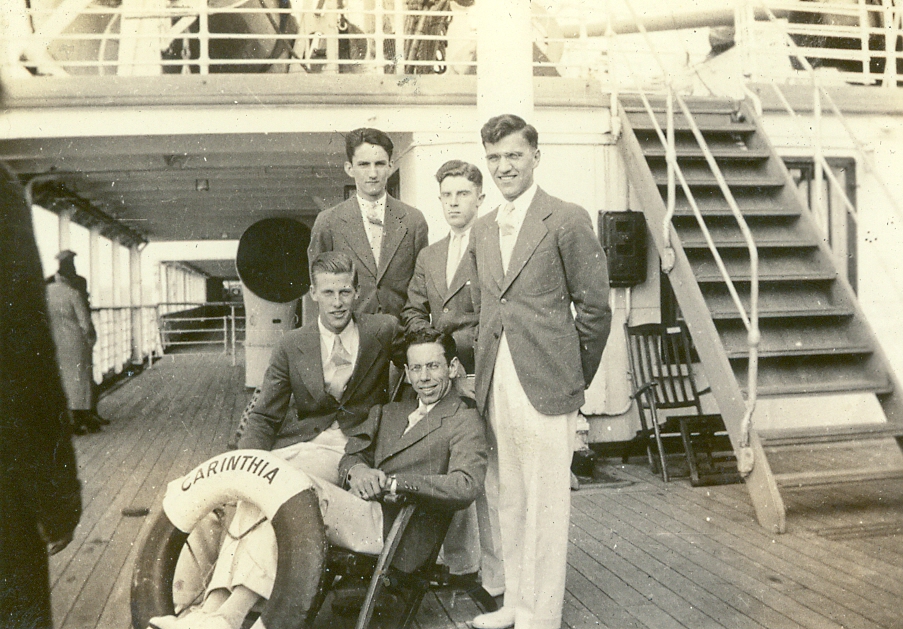
The 1930s were a very difficult time for Iowans. Farm prices were depressed, the weather was harsh, and work was hard to find. The situation was especially difficult for college students. Even the minimal cost of tuition--then about $30 per term--at the Iowa State Teachers College, now the University of Northern Iowa, was a sufficient barrier to reduce enrollment severely. Some students, such as Leroy Blumer, whose account of attending the Teachers College in 1933 is chronicled in another essay, stayed in school only briefly and then left for home or went out to find work.
But some students managed to stay in school and achieve a degree during those difficult times. They shaved expenses and picked up a little money wherever they could. One such student was Richard Sucher. He enrolled at the Teachers College in 1929 and received his degree in 1933. However, even among the relatively small number of students who graduated in 1933, Richard Sucher had a special distinction. After graduating, he managed to find a way to sail to England free of charge and then spend the summer of 1934 touring that country with minimal expense.
During that trip, Richard Sucher kept a journal. In a separate page, the Rod Library Special Collections staff offers a scanned version of that journal as well as a transcript of the text.
Richard Sucher's Family
Richard Cobb Sucher, the subject of this essay, and his identical twin brother Robert, were born in Cedar Falls, Black Hawk County, Iowa, on December 17, 1911. They were the sons of Harvey Ernest and Louella Grace Kroesen Sucher.
The Sucher Family
Harvey Ernest Sucher was the son of William L. and Maria Tobias Dressler Sucher. William Sucher was born in Pennsylvania in August 1840. He was of Alsatian descent. His family emigrated from Alsace to Ohio in about 1829. By 1850, William Sucher's family was in Downers Grove, Illinois, where they farmed for many years.
Maria Tobias Dressler was born on December 3, 1839, in Schuykill County, Pennsylvania. She had three children from an earlier marriage before she married William Sucher in 1873. They had three children together: Harvey Ernest, born 1874; Mabel Elnora, born 1879; and Frank, born 1882.
Harvey Ernest Sucher, Richard Sucher's father, was born on November 23, 1874, in Downers Grove, Illinois. By 1881 or 1882, William and Maria Sucher, along with their three children, were farming in Ogden, Boone County, Iowa. When they retired from farming, they moved to Cedar Falls, Iowa. Their son Harvey built a house for them and his sister Mabel at 806 Clay Street. Maria Sucher died on February 3, 1919, and was buried in Fairview Cemetery, Cedar Falls, Iowa.
Harvey Sucher married Pearl Smith of Boone, Iowa, in 1902. She died in 1905. They had no children. Harvey then married Louella Grace Kroesen in Cedar Falls, Iowa, on May 11, 1909.
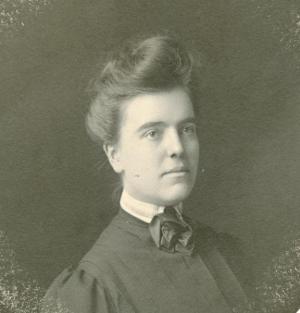
The Kroesen Family
Louella Grace Kroesen was the daughter of James L. and Mary Elizabeth Cobb Kroesen.
James L. Kroesen was born in Ohio in May 1849. He was of English and Dutch descent. Mary Elizabeth Cobb was born in Iowa City, Johnson County, Iowa, in April 1858. Her family, of Scotch and Welsh origin, had deep roots in the United States. At least one of her ancestors was in Connecticut by 1629. James and Mary Kroesen were married in Benton County, Iowa, on April 18, 1878. They had three children: James Burton (born 1880); Grace Louella (born 1881); and Charles Edgar (born 1883).
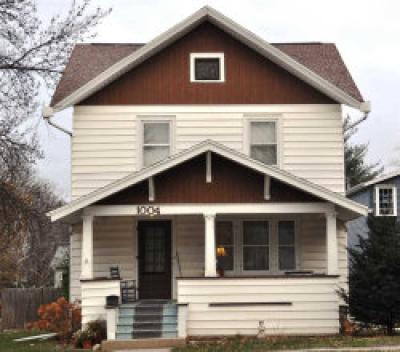
James Kroesen left the family and moved to the West in 1896. Mary Kroesen and their three children moved to Cedar Falls in 1897 and initially lived in a rented house. All three of the Kroesen children attended the Iowa State Normal School, now the University of Northern Iowa. James Burton (Burt) Kroesen attended the Normal School from about 1899 through 1901 and went on to edit small town Iowa newspapers. Charles Edgar Kroesen attended the Normal School at about the same time and made his career in teaching and school administration. In 1903 the family bought a new house at 2523 Olive Street. Over the next six years they rented rooms to Iowa State Normal School students. The Kroesen house was a congenial gathering and meeting place for friends, family, and Normal School classmates.
Grace Luella Kroesen received a Normal School diploma in 1900 and then taught in Marcus, Iowa, in 1901-1902, where some of her family lived. She returned home and assisted her brother Burt in editing the Grundy County Gazette in Dike, Iowa, in 1903. She then re-entered the Normal School and received a degree in home economics in 1907.
When Grace Kroesen married Harvey Sucher in 1909, the family sold the Olive Street rooming house and moved into a smaller house at 1004 Franklin Street, Cedar Falls, that Harvey had built.
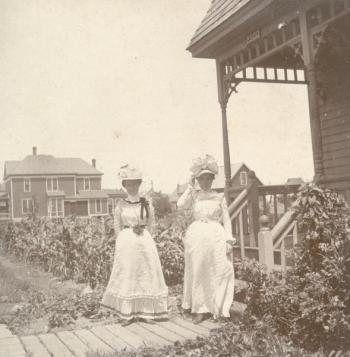
Harvey Sucher worked as a carpenter at the Weisbard Planing Mill and the Harris Woodworking Mill in Cedar Falls. He was a skilled woodworker and a self-taught musician, who played in the Cedar Falls Concert Band.
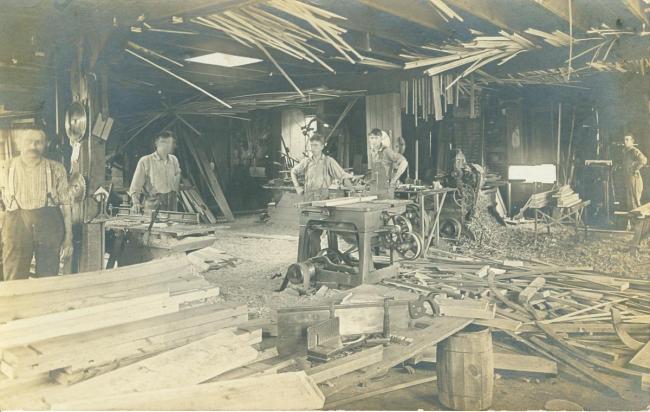

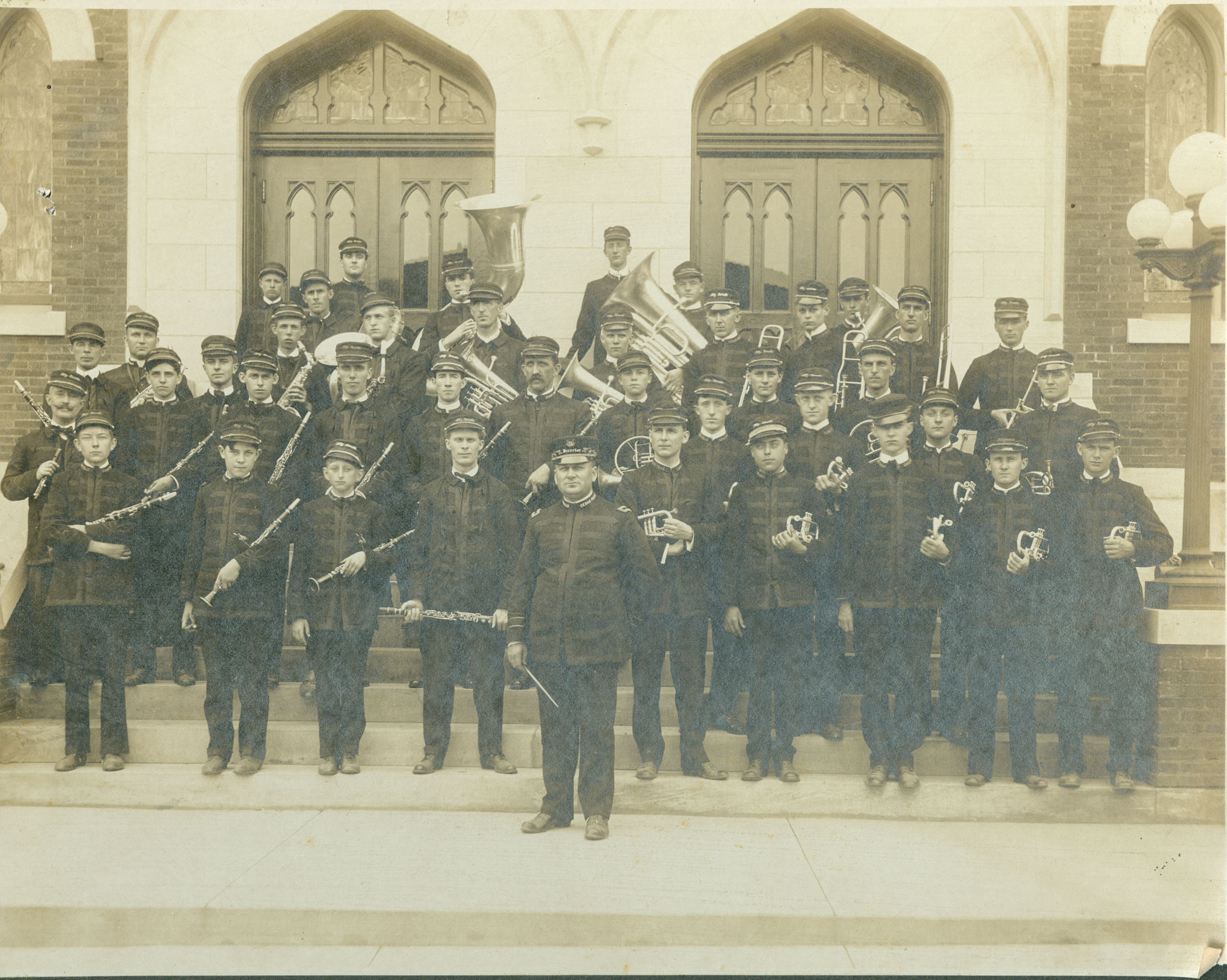
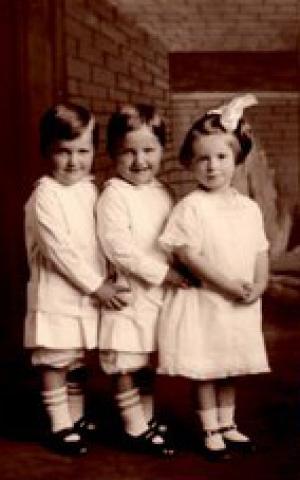
In 1910, Harvey and Louella Sucher adopted a child, Ernestine. Ernestine Sucher Reeder died in September 2002, in Wells, Minnesota. On December 17, 1911, their identical twin sons Richard and Robert were born. Robert was born ten minutes after his brother Richard. And in 1918 they adopted an infant named Margaret. Margaret Sucher Walker died on April 2, 2012 in Tampa, Florida.
Harvey Ernest Sucher died in 1957 and was buried at Linwood Park Cemetery, Boone, Boone County, Iowa. Louella Grace Kroesen Sucher died October 18, 1978, in Zearing, Iowa. She was buried next to her husband at the Linwood Park Cemetery. Their son Robert, Richard's twin brother, died in 1999. He is also buried at the Linwood Park Cemetery.
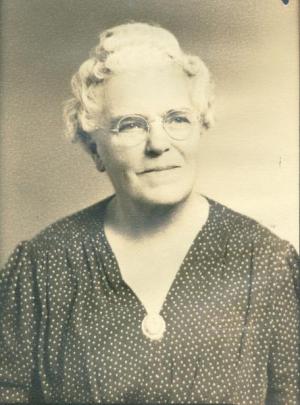
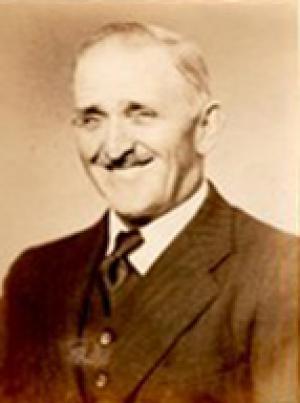
Life at the Teachers College
The Sucher family lived in a number of places in Cedar Falls. Harvey Sucher had many jobs. After leaving the woodworking mills, he worked in a foundry, remodeled houses, and started new businesses. He bought small farms and built a small, high quality dairy herd. He was a skilled, hard worker with a creative mind, but his many enterprises did not succeed over the long term. Louella Sucher had a college degree from the Teachers College and was comfortable in an intellectual atmosphere. She also had firm ideas about the things that she believed were valuable and necessary in life. By 1930, with the national economy descending into the Great Depression, the family had lost nearly everything. Harvey Sucher took whatever work was available. In 1933, after finding a way to buy a one hundred acre farm in Boone County, the family moved away from Cedar Falls.
This was the background against which Richard Sucher was raised. He and his brother Robert worked hard to help their parents in their years in Cedar Falls. They assisted their father in his various enterprises. They took odd jobs of all sorts. During his last two years of high school, Richard worked in a local greenhouse. He and his brother Robert graduated from Cedar Falls High School in 1929. Richard was heavily involved in 4-H activities, typically associated with raising and showing prize-winning cattle locally, around the state, and occasionally outside of Iowa. He likely did not have time to participate in many high school activities.
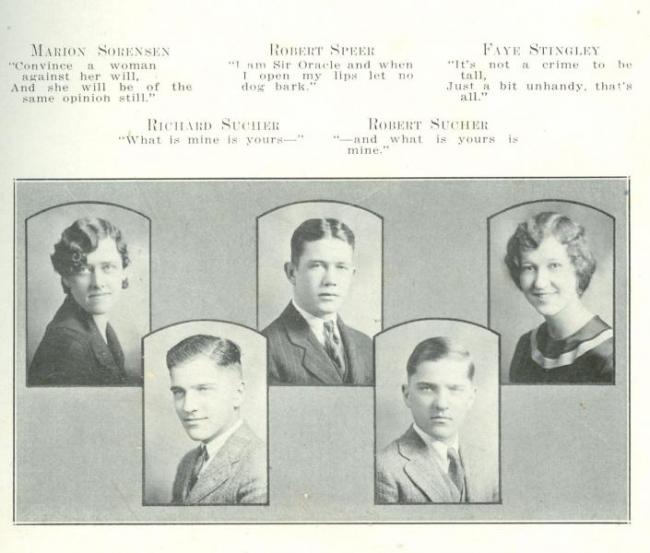
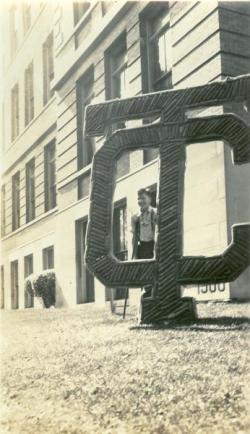
Richard and Robert enrolled in the Iowa State Teachers College for the 1929 fall term. To some extent, that seems like a natural choice. Their mother and two uncles had attended school there. And it was certainly close to home. However, many years later, Richard's wife Florence stated that neither Richard nor Robert had a particularly strong inclination toward a teaching career. But their mother Louella believed that it was the right course for both of them.
Whatever the family circumstances, both young men entered and ultimately graduated from the Teachers College. Richard Sucher enrolled in the Manual Arts curriculum and quickly became involved in campus activities. He joined the Eta chapter of the Phi Tau Theta social fraternity and became a member of the Troubadours Glee Club. That glee club was a strong musical group, but it was regarded as something of a training ground for the more prestigious Minnesingers Glee Club. In the summer of 1929, Richard and several other Teachers College students attended the annual Young Men's Christian Association meeting in Lake Geneva, Wisconsin, where they heard lectures by prominent speakers on facing the realities of life. In the fall of 1930, Richard was elected treasurer of the freshman class. In that school year he continued to be active in Phi Tau Theta and the Young Men's Christian Association. He also moved up to the Minnesingers Glee Club as a first tenor.
In September 1931 Richard Sucher was elected organization editor of the college yearbook, the Old Gold. He played in the percussion section of the Men's Band and the College Symphony Orchestra. He continued to sing first tenor in the Minnesingers. And again showing his interest and talent in music, he served as vice president of the Beta Mu chapter of Phi Mu Alpha Sinfonia, the prestigious music honorary society.
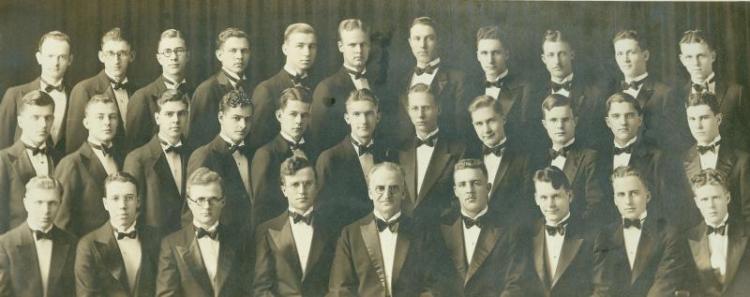

Richard Sucher also pursued musical interests outside of standard college groups and venues. At some point, probably in the 1931-1932 school year, he and friends started a band called The Campus Playboys. The November 28, 1932, issue of the student newspaper, the College Eye, noted that "Richard Sucher and his Campus Playboys" would be playing from 6:45 until 7:45 at the Monday evening recreational dance in the Women's Gymnasium. There are several interesting things about this announcement. First, Richard Sucher is clearly the leader of this group. Second, the article implies that students were already familiar with the group and its music: the band did not seem to need an introduction. Merely mentioning its name was enough. So, it seems likely that the group had already played on campus for awhile. And, third, the "recreational" aspect of the dance implies that it would be a short, informal affair that might well feature current, popular music rather than a program of staid ballroom favorites. By way of contrast, that same article also announces the regular Friday evening dance. That three-hour program would feature an orchestra rather than a band.
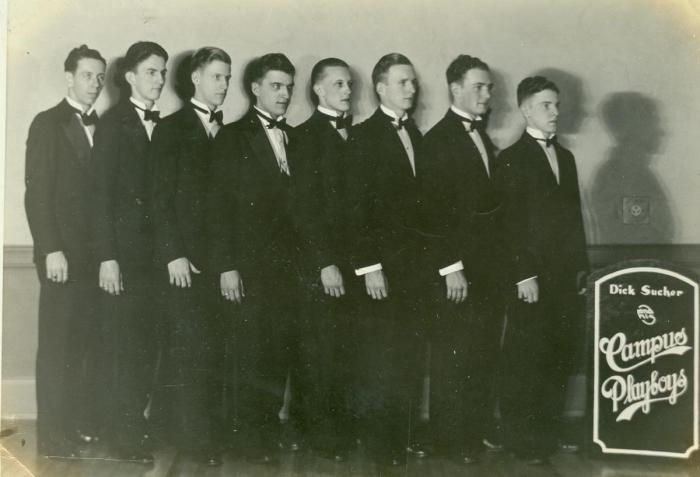
For the next several years, the College Eye contained article after article about performances by the Campus Playboys. The group had apparently become a campus dance favorite. In the spring of 1933, Richard Sucher served on one of the committees for the Washington Ball, one of the biggest dances of the year. He and the Playboys performed at a two hour recreational dance on campus on March 3, 1933 and then for a three and a half hour "sport dance" given by the Epsilon Phi Epsilon sorority at the off-campus Mandalay in Cedar Heights on April 22, 1933. In July 1933, Richard Sucher was one of three students who conducted the College Band in a summer concert on the east side of the Auditorium Building (now Lang Hall).
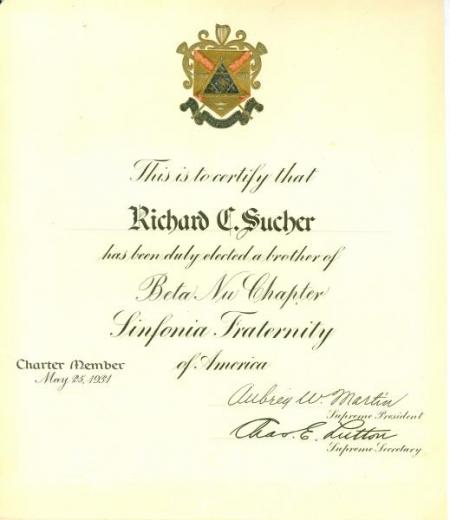
In the fall of 1933, Richard Sucher was appointed Supreme Councilman of Phi Mu Alpha Sinfonia. He and his band played for a freshman dance, the Frosh Frolic, on October 7. Over two hundred freshmen attended. They played for the Pi Phi Omega sorority fall dance on November 18 at Black's Tea Room in Waterloo.
On November 28, 1933, at the end of the fall term, Richard Sucher received his Bachelor of Science in Manual Arts degree. He was one of eleven students to receive a degree at the mid-year Commencement ceremony. He was likely very glad to have finished his degree. His band engagements were such that he sometimes attended an 8 o'clock class in a tuxedo that he had worn to a late night engagement. And, frequently tired after a performance, he had difficulty staying awake in class. However, he did not immediately seek a teaching position after graduation. Perhaps he could not find a good job at the time of his November graduation. Or perhaps it made more sense to stay around campus, where he could make a little money with the band. On January 15, 1934, he and his band were again playing for a campus dance. Their engagements were heavy over the next several months:
- January 27, 1934, Chi Pi Theta sorority dance, Black's Tea Room
- February 17, 1934, V. O. V. Sigma Phi sorority formal dinner dance, Cedar Falls Woman's Club
- February 23, 1934, Farmers' Frolic, Commons recreation room
- March 3, 1934, Prison Prom, Bartlett Hall
- March 12, 1934, Commons dance
- April 28, 1934, Pi Phi Omega, Commons
This is not an exhaustive list of band engagements. The Campus Playboys played at many other dances off campus, including regular dates at a Gladbrook dance hall.
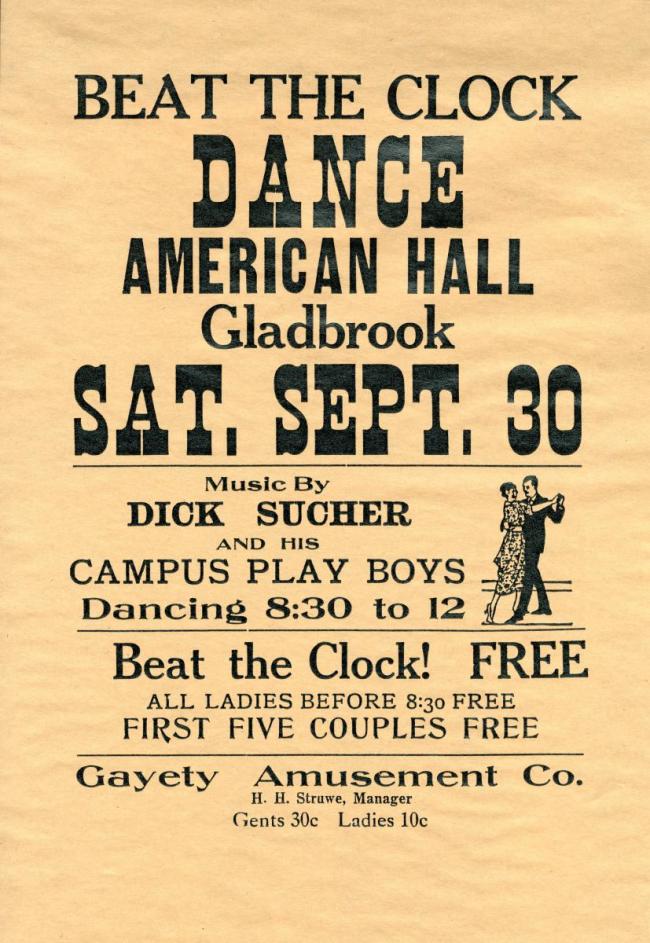
But in addition to booking and playing a large number of dances, Richard Sucher had been busy with something else during the early months of 1934. He had been attempting to make arrangements to travel to Europe. He wrote to Cunard line offices in New York City, and to many other shipping companies, to offer his dance band's services. In exchange for free passage, he proposed that his band would play dance music on one of the ships. They would play on the way to Europe, spend a few weeks on the Continent and in England, and then play on another liner's return voyage to the United States.
Richard Sucher and the Cunard line exchanged a considerable volume of correspondence in early 1934. Likely to the band's surprise, Cunard finally agreed to hire them. They signed a contract on April 10, 1934. Their upcoming trip was probably a big topic of conversation on campus that spring.
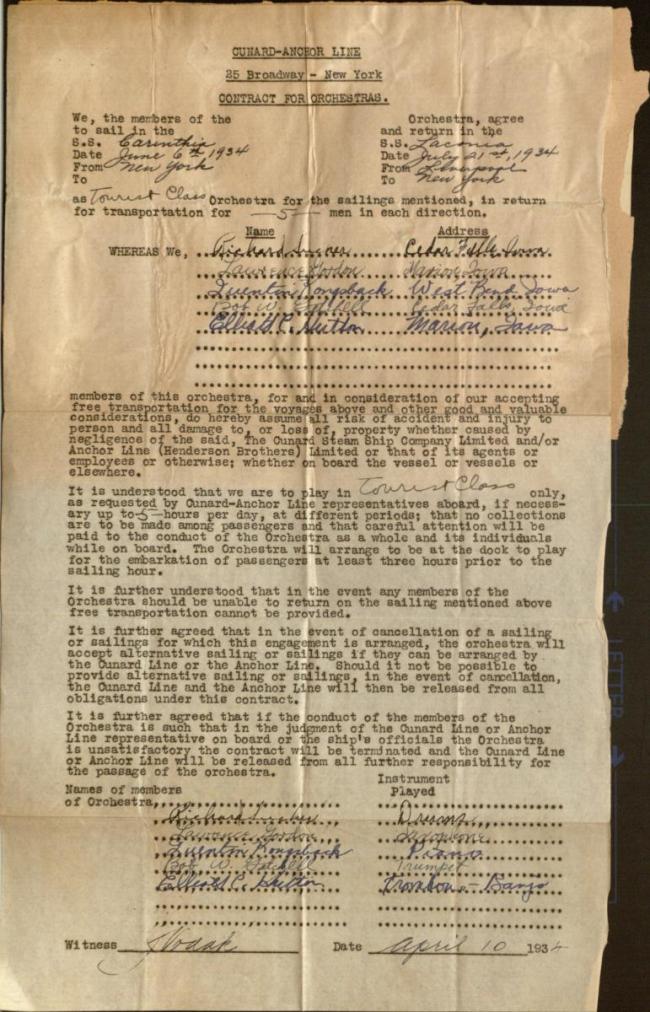
Teachers College President O. R. Latham even gave them a large school banner, now a part of the University Archives collection, to take along with them on their journey. Richard Sucher's bandmates were Quentin Kongsback, Elliot Hutton, Lawrence Gordon, and Bob Getchell. During their passage to Europe, they would play mostly on the "A" deck of the Cunard liner Carinthia for tea dances in the afternoon and dinner dances in the evening. The rest of their time aboard would be theirs to use as they saw fit. In return for their performances, they would receive room and board on the Carinthia. But they would be responsible for getting to New York City on time, for doing their own laundry, and for incidental expenses. They planned to sail in June from New York to Havre and then take a train to Paris. After seeing the sights there, they would travel to Germany, Denmark, Sweden, The Netherlands, Scotland, and England. They would depart from Liverpool for the return trip to New York in late July. And, on the way home to Iowa, they would stop at the World's Fair in Chicago. It was a remarkable itinerary.
There would be modifications to trip plans--some substantial--during their summer abroad. But they still managed to accomplish things that Iowa college students of that day could only dream about. Richard Sucher kept a daily journal of his experiences during that summer. He also had a camera that he used to photograph the scenery, impressive historical sites, and his friends.
We present below the highlights of his trip.
The Trip to New York
The trip started quite literally from College Hill on Friday, June 1, 1934. Richard Sucher hitched a ride to downtown Cedar Falls with Professor Sara Riggs. He then caught a ride to Waterloo, where he took care of some business. Two more hitched rides took him to Cedar Rapids. And another ride took him to Marion, where the band members packed for the big trip. They finished packing in good time and decided to take off at 11PM on June 1 rather than wait until morning to start. Their friends Alvin Johnson and Maurice Boatman would load up their Pontiac and take the band to New York.
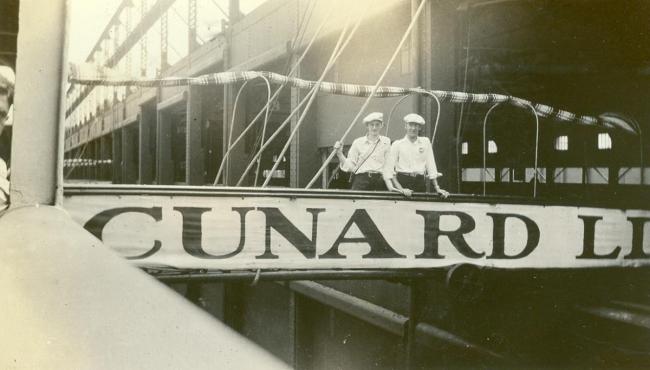
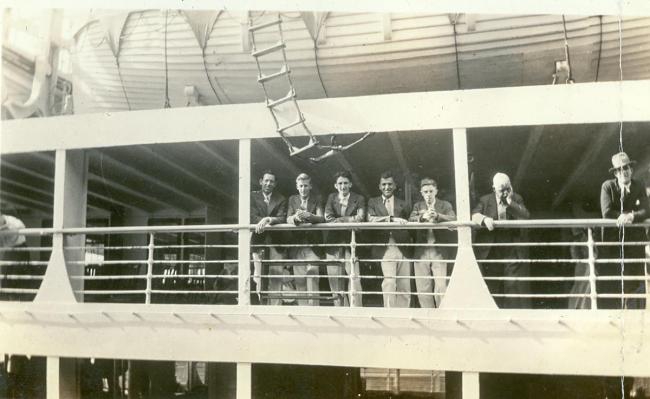
In Marion, they got onto the Lincoln Highway, roughly what is now Highway 30, and headed east. They stayed on the Lincoln Highway all the way to the East Coast. The Lincoln Highway Association has an extraordinary interactive map that gives a nice picture of band's route.
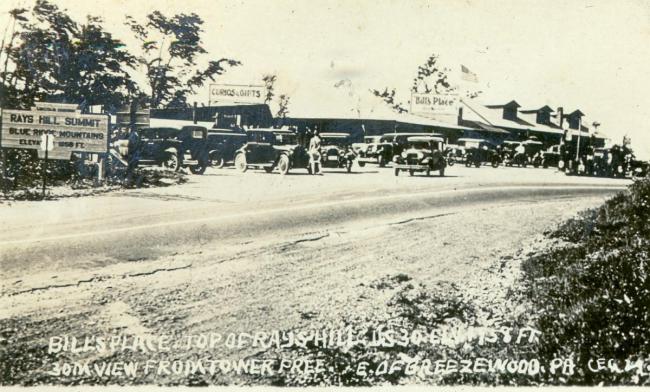
They crossed the Mississippi River at 10AM on June 2. They passed through Chicago Heights, Illinois, and Fort Wayne, Indiana, before they stopped for the night of June 2-3 at a tourist camp at Upper Sandusky, Ohio. They then drove on through Pittsburgh.
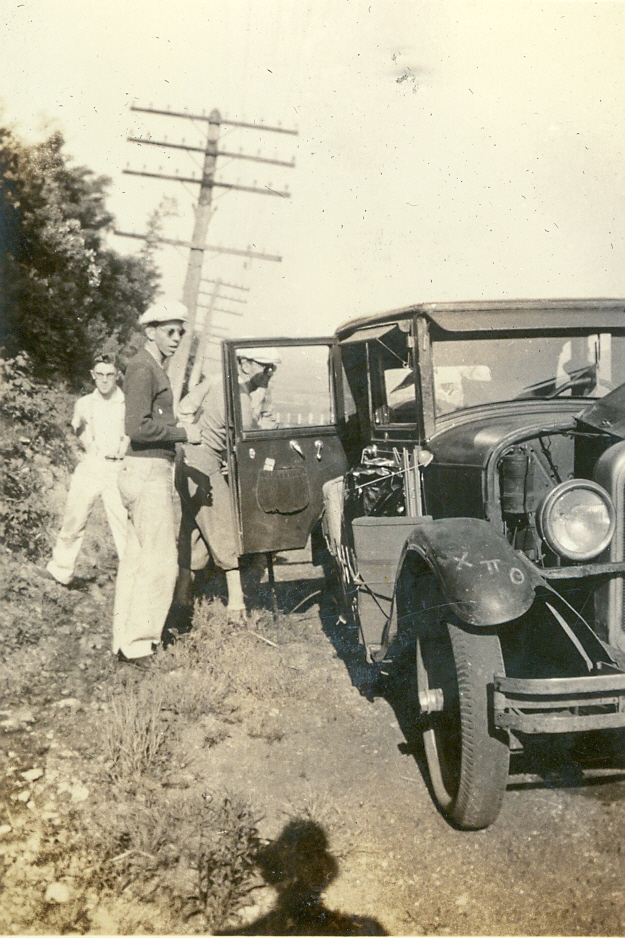
The hills and mountains of the Alleghenies gave their car a workout, but they pressed on through Gettysburg and then to Philadelphia on June 4.
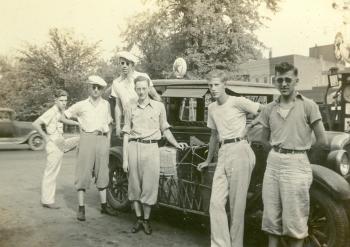
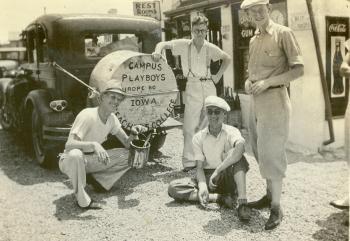
The band and its drivers take a break.
They reached New York City early June 5 and immediately checked in at the Cunard line office. They saw the sights of the big city on June 5 and then boarded the Carinthia on June 6.
Onboard the Carinthia
The band played its first sets for sparsely attended dances on the afternoon of June 6 and again that evening.
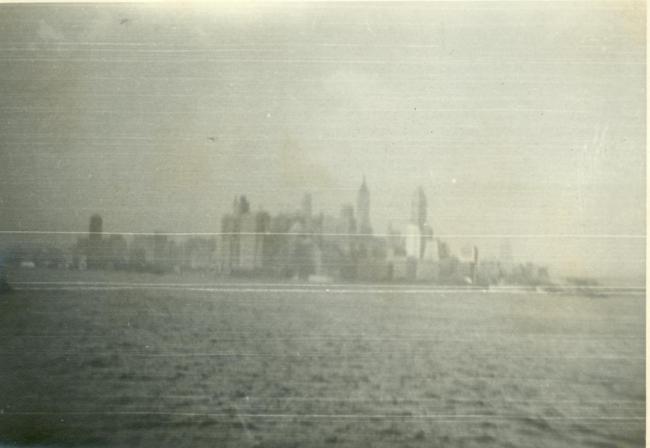
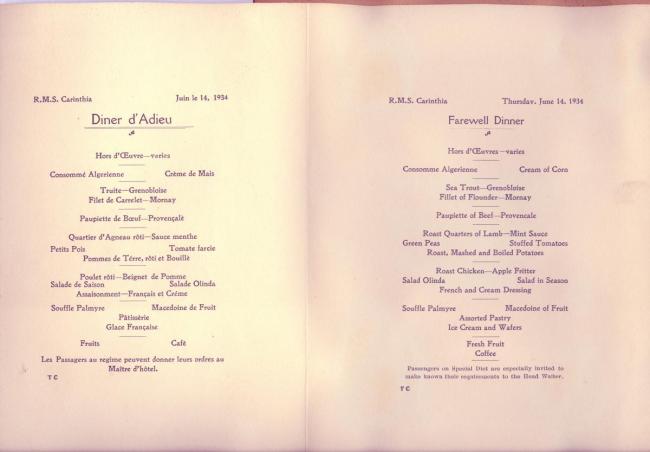
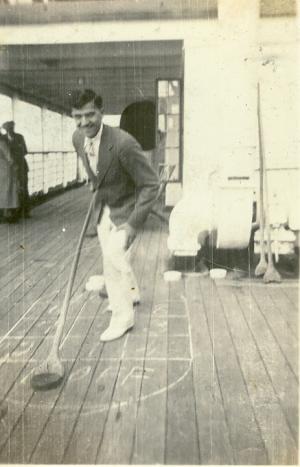
Richard and the band began to adjust to life aboard ship. At least initially they enjoyed the food and managed to find the bars.
But the sea was rough and they all succumbed to seasickness. No one ate much and dances were canceled due to the rolling seas. Richard came out of his seasickness more quickly than his bandmates.
Even though his appetite was still depressed, he was the first of his friends to be able to get out, walk around, and begin to meet fellow travelers. He met several people, including a young woman named Betty Lewis, from Muskegon, Michigan, as well as Marcel Maurel, a cover artist for Time magazine.
They talked, walked around the ship, and played piano and table tennis. Talking with Monsieur Maurel was an eye-opener for Richard Sucher. Monsieur Maurel knew Lily Pons, Jan Paderewski, Joan Crawford, Franchot Tone, Arthur Rubenstein, Maurice Ravel, and other famous personalities. His Time magazine cover sketch of James Joyce that appeared earlier in 1934 became an iconic image of the controversial author.
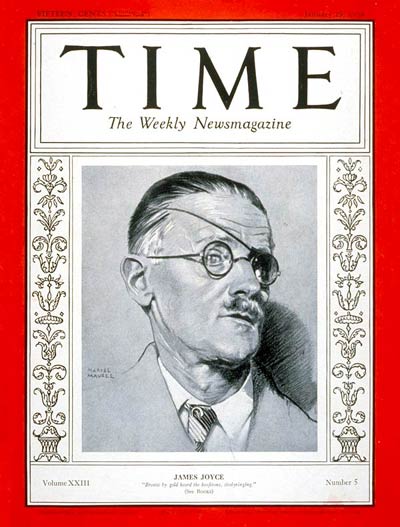
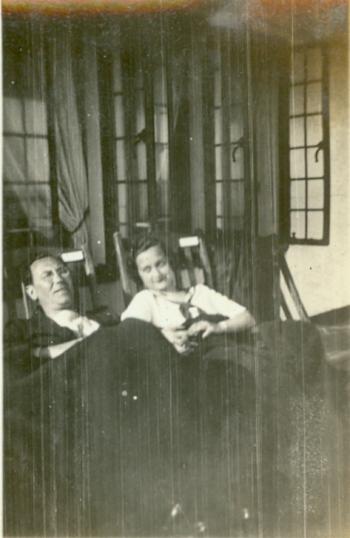
Both Betty Lewis and Monsieur Maurel were also accomplished pianists and composers. Richard Sucher wrote:
We think we are educated after graduating from T. C. or any other Mid-West school. But
we are not. One has to meet up with people such as Marcel and also girls such as Betty
before you realize our lack of education. It leaves me speechless. Marcel's politeness
makes me feel like a tramp.
The boys eventually got their sea legs and digestive systems in order by June 9. They played their sets, including a well-received concert, on June 10.
They continued their work and their play over the next few days, with Richard Sucher seeming to spend most of his time with his new onboard friends when he was not performing with the band. He stayed up with Monsieur Maurel, Betty, and her friend Dorothy Bearce until 4AM some nights and occasionally slept until noon the next day.

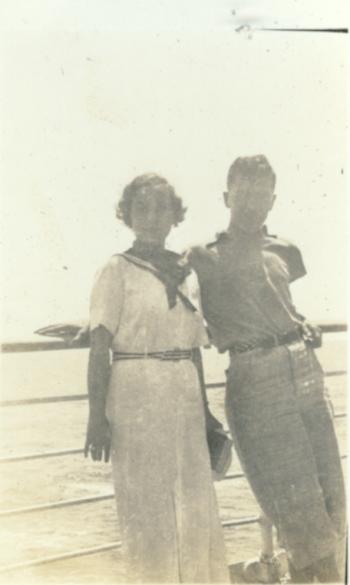
On June 13, he had his landing card changed from Havre, France, to Southampton, England. The other band members would debark at Havre. At this point in his journal, Richard Sucher offered no plainly stated explanation for this radical alteration of plans. His bandmates would go to France and he would go alone to England. There is no indication of a quarrel with his friends. He certainly still felt strongly about them. When they parted at Havre, he shook their hands and wrote in his journal, "gosh what a lump I had in my throat." Later comments seem to indicate that he could not afford to travel on the Continent with his friends as he had planned. Even though he was the organizer of the trip, he did not seem to have as much money as his bandmates. He apparently calculated that it would be less expensive for him to spend his summer in England.
The Carinthia arrived in the English Channel and then docked at Havre on June 14. After his bandmates debarked, Richard Sucher was on his own.
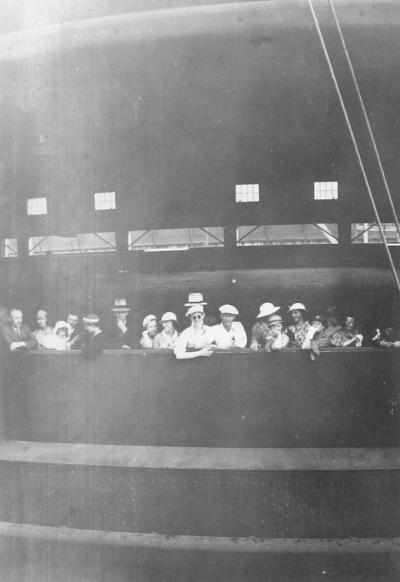
Richard Sucher's Tour of England
The Carinthia docked in Southampton on June 15. Richard Sucher said good-bye to his shipboard friends, Betty Lewis, Dorothy Bearce, and Marcel Maurel. He then debarked and cleared immigration. He sent a bag on to London via American Express, purchased a bicycle for one pound, and began his whirlwind tour of England. After staying the night at the YMCA and then getting used to left lane English traffic, he rode on to Shedfield, where he visited the family of someone whom he had met onboard ship. They gave him a quick lesson in English agricultural practices and a look at country churches. Most of all he remembered a wonderful lunch consisting of bacon, bread, butter, tea, strawberries, tomatoes, cake, onions, and lemonade. They sent him on his way with six sandwiches, cold pork, and cake. He rode forty-five miles that day. On the night of June 16-17, he slept in a haystack, a practice that he would use often to save money.
He enjoyed the scenery along his way through Guildford and on toward London: country estates, hedges, woods, fences, many bicycles, and small English cars. He stopped at Wimbledon to see the beautiful tennis courts and then, after a forty-mile day, he found a room on Vauxhall Road after he entered London. The room had access to a bath, but he would need to take care of his own food arrangements. After dealing with confusing street layouts, he found his way to the Park Lane Hotel, where his new friends Betty and Dorothy were staying. They all talked for hours before he returned to his room.
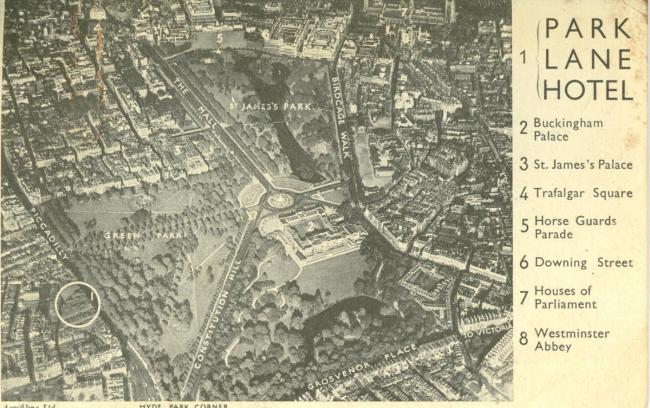
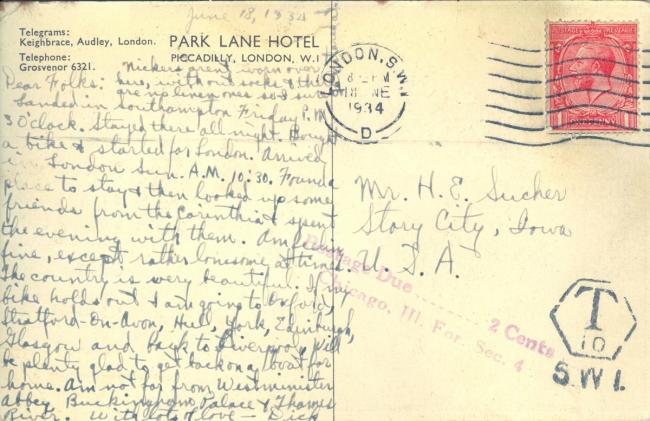
The postcard was addressed to Mr. H. E. Sucher, Story City, Iowa, U. S. A.
June 18, 1934
Nickers aren't worn over
here without socks & there
are no linen ones so I sure get stared at.
Dear Folks:
Landed in Southampton Friday P. M
3 o'clock. Stayed there all night. Bought
a bike & started for London. Arrived
in London Sun. A. M. 10:30. Found a
place to stay & then looked up some
friends from the Carinthia & spent
the evening with them. Am feeling
fine, except rather lonesome at times.
The country is very beautiful. If my
bike holds out I am going to Oxford,
Stratford-On-Avon, Hull, York, Edinburgh,
Glasgow and back to Liverpool. Will
be plenty glad to get back on a boat for
home. Am not far from Westminister [sic]
Abbey, Buckingham Palace & Thames
River. With lots of love--Dick
On June 18 Richard Sucher slept until 1PM. He cleaned up and walked around. He saw many prostitutes on the streets. He was impressed by their clothing style, but showed no inclination to speculate further about them. That night he and Betty walked to Soho at midnight and found a club, the "Cossack ", that was open late. The club featured "the only Negro Band in London". The club did not require formal wear, so they went in and enjoyed dancing to "The St. Louis Blues". The club closed at 1:30AM, but they vowed to return another evening.
On June 20 he did some sightseeing. He visited Westminster Abbey, Whitehall, the National Gallery, St. Martins, the Temple, Hyde Park, Buckingham Palace, Marlborough House, and other sights. He enjoyed a performance by the Scots Military Band. The next day he visited the Tate Gallery, London Bridge, the Tower, the Royal Mint, the Bank of England, the Royal Exchange, and St. Paul's Cathedral. That evening he and Betty headed back to the "Cossack" to hear Rudolph Dunbar's band play some new, snappy tunes. While there, they met several sophisticated gentlemen and visited an apartment belonging to one of them. There they enjoyed drinking whiskey and soda and smoking English and Egyptian cigarettes. On June 23 Richard and Betty visited Parliament and watched the changing of the guard ceremony at St. James Palace.
But Richard Sucher's time in London with his new friends was drawing to a close. Betty and Dotty were leaving London and Richard was waiting to have his bicycle repaired so that he could continue his tour. On June 24, he said good-bye to his friends, completed bike repairs and did more sightseeing early on June 26, and was on the road again that day. He stopped in Rochester, slept outside that night, and arrived, after a sixty mile ride, in Canterbury on June 27. He marveled at the beauty of the countryside and Canterbury Cathedral. He stopped at a farm for milk and found that the dairyman had lived in Wisconsin for twenty years. They compared notes on English and American farming practices. He then headed for the Croyden Airdrome, where he saw some impressive airplanes before heading back to London. There he again enjoyed whiskey and cigarettes with the friend whom he and Betty had met at the "Cossack". Then he headed out to Hampton Court. He enjoyed the picturesque ride along the Thames as he made his way to Astor, Windsor Great Park, and Windsor Castle. He rode past Eton College, visited the grave of Thomas Gray, and headed toward Henley. It was a fifty-mile day.
He then took it easy for several days on June 30 and July 1. He visited Henley and saw the site of the Regatta. He mended his clothing and learned to enjoy the offerings of English pubs. He became especially fond of what he called a "shanty" in his journal. This is actually a shandy, a mixture of beer and ginger beer. He pushed on to Oxford on July 2, where he wondered at the antiquity of that university, the beauty of the Bodleian Library, and the quality of beer brewed especially for Magdalen College.
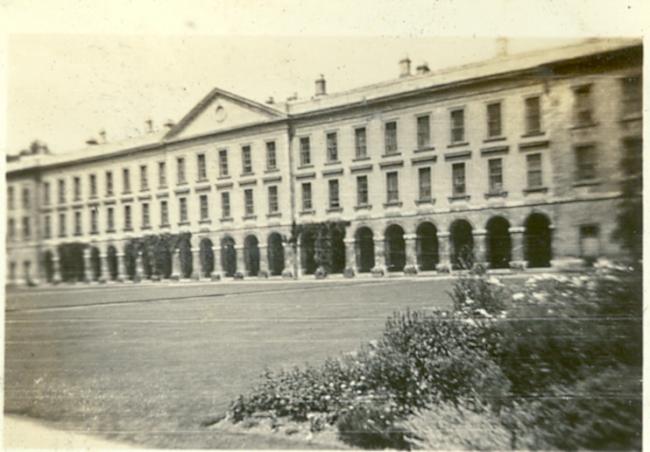
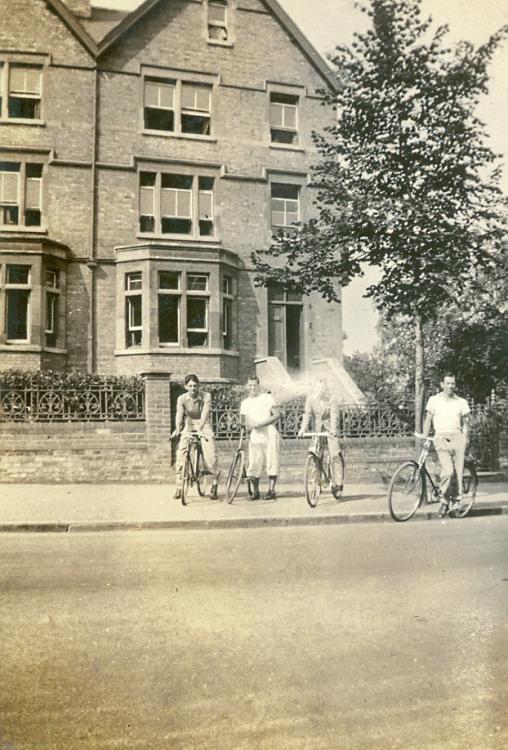
Then something extraordinary happened. Someone said, "Hello, Dick" twice. He turned around and was amazed to see three of his bandmates standing there with their bicycles. They quickly explained that Paris was so expensive that they had moved on to London after only a few days on the Continent. They had actually been in London while Richard Sucher was there. After a long talk about their experiences, they all went to the YMCA hostel and arranged for Richard to stay with them free of charge.
The boys rode around the Oxford area for the next few days. On July 4, they rode down to Henley to see the renowned Regatta. They went swimming. They tried to play cricket. And they enjoyed good times at pubs. They even managed to get kicked out of several local establishments for slightly rowdy behavior. On July 5, they rode to Stratford-on-Avon to see the Shakespeare sights. That night the other boys found rooms in an old house, while Richard bought some food and found a haystack in which to sleep. They spent the next several days around Stratford before they again decided to go in different directions. On July 7, the others headed for Birmingham and Chester, and Richard started for Cambridge.
After riding just a few miles, Richard Sucher took it easy for a day. He wrote a letter, enjoyed the sun, and slept in a haystack. He did some serious riding on July 9: eighty-five miles. He picked up food along the way as he passed through Banbury and Sulgrave before approaching Northampton. He felt good and believed that he could ride 125 miles in a day, especially with the very long British summer days. He enjoyed the beauty of Cambridge University and Ely Cathedral on July 10. He marveled especially at the large stained glass windows that he saw in many places.
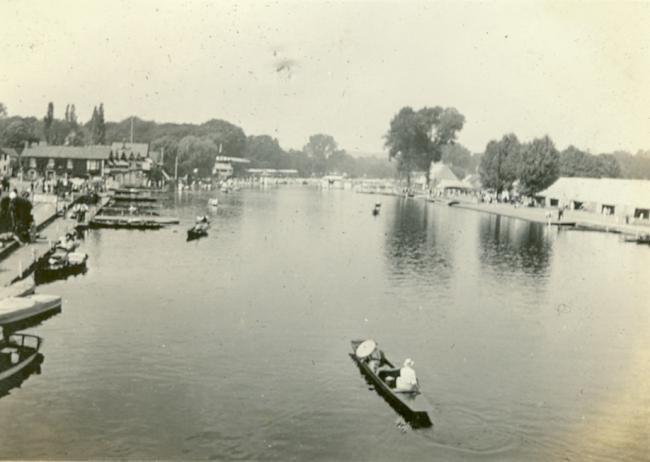
Beginning on July 11, a new feature appeared in his journal. In that day's entry he wrote, "Only 10 more days till--?--" This feature shows that Richard Sucher was clearly beginning to look forward to his return to the United States. In just ten days he was to be in Liverpool to board the Cunard liner Laconia for his homebound voyage. For this and the next nine journal entries, he counted down the days until the end of his bicycle journey.
On July 11 he visited Boston Cathedral, on July 12 he was in Lincoln, and then made it all the way to York on July 13. These were long rides. Rain got in the way of his picture-taking for awhile, but he managed to find food along the way and warm places to sleep. On the evening of July 13 he decided to take a room for the night. He got a hot bath ("Boy it sure felt good"), a bed, dinner, and breakfast for five shillings. This further depleted his cash and made him think that he would need to rush to Liverpool, economizing severely along the way, but he clearly needed at least one comfortable, restful night.
The rest of his bicycle trip was hectic, with long, eighty mile rides punctuated by short sightseeing stops. On July 14 he visited Fountain Abbey and Windemere. Riding up and down hills was trying, but he enjoyed the countryside. On July 15 he passed through Sedbergh, into Penrith, and on to a youth hostel near Gretes Green. He covered over eighty miles that day. On July 16 he reached Dumfries, just over the Scottish border. There he hoped to buy a beret, but he could not find one his size. Then he turned around ("Now for Liverpool") and headed south and west through Carlisle, where he turned his one thousandth mile on his bicycle. From the front door of the house where he stayed he could see Solway Firth and the Dumfries Hills.
On July 17, after stopping for shandy at a pub, he visited Wordsworth's Dove Cottage in Grasmere. It was a ninety mile day, passing through Lancaster and Preston, with some beautiful countryside around him. On July 18, at 1:30PM, he rode into Liverpool on a flat tire. It happened to be the day when King George V and Queen Mary dedicated the Mersey Tunnel, an event attended by 200,000 people. He picked up his mail and quickly found his bandmates. For the next several days he and his friends relaxed, ate, and walked around town. They boarded the Laconia on July 21.
The Trip Home
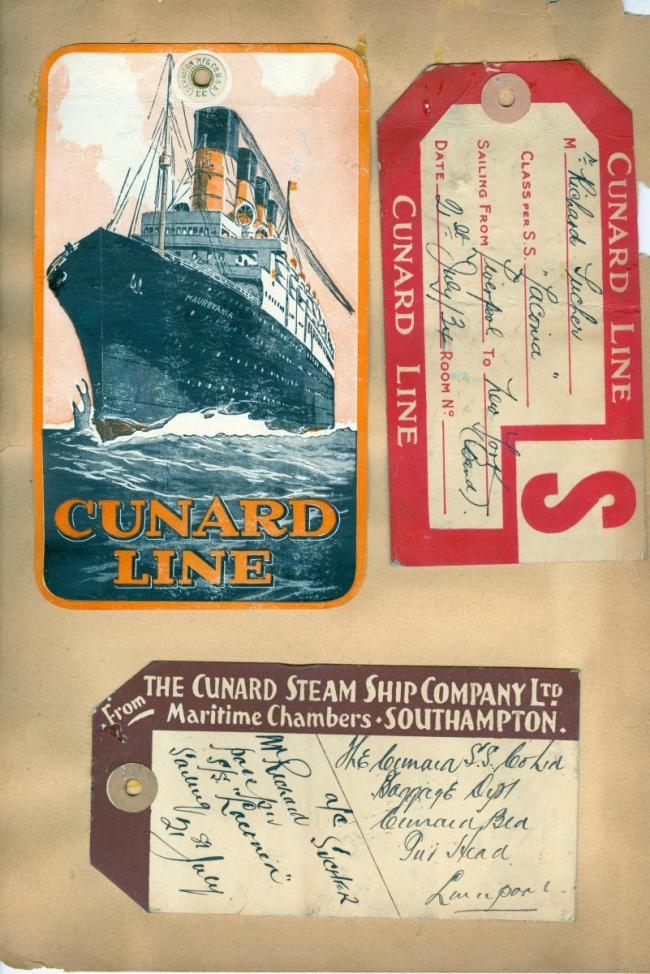
The Laconia sailed on July 21 at 1:30PM. Richard Sucher and his friends fell right back into their routines onboard the Laconia. They ate well and regularly, they rehearsed (even though someone had stolen Richard Sucher's cymbal), and they played for dances. They must have been a tight group. They had been away from rehearsing and performing for six weeks, yet Richard Sucher wrote, "and did we play good--and how". His journal entries on the return voyage are brief and ironically repetitive. The entry for July 24, quoted below in its entirety, is a good example:
Woke at 6 o'clock. Back to bed for a short snooze.
Breakfast--Slept--Lunch--Slept--Dinner--
Dance. Up to Cabin Dance for awhile--
Then to bed--Big plate of sandwiches.
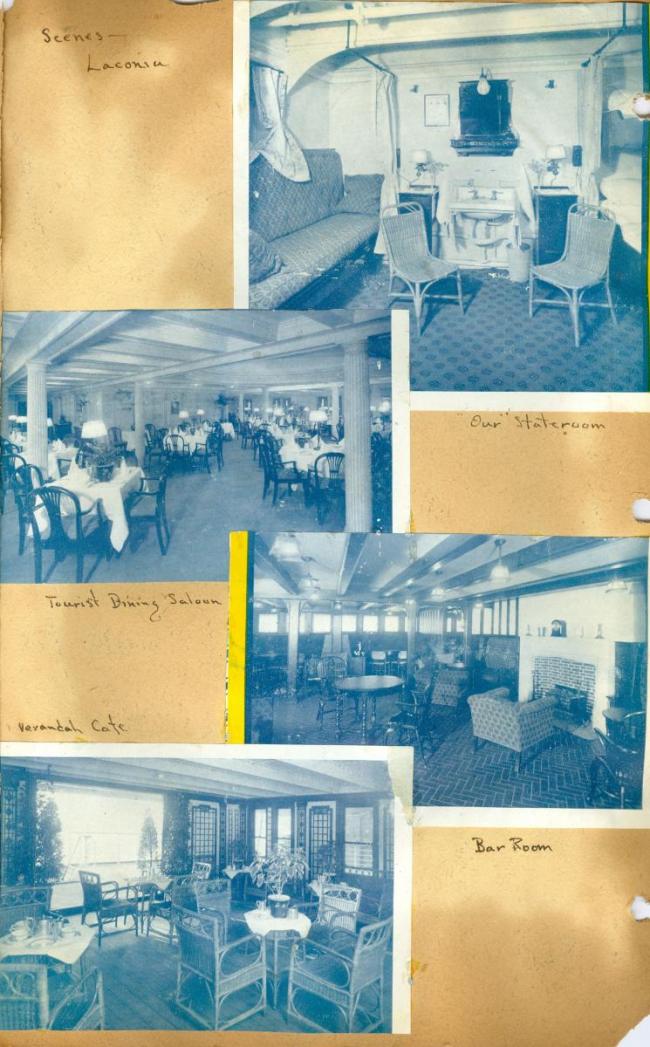
After passing through some foggy sailing days, the Laconia dropped anchor in Boston harbor on July 29. Two days later, after cruising slowly in dense fog, the ship docked in New York City.
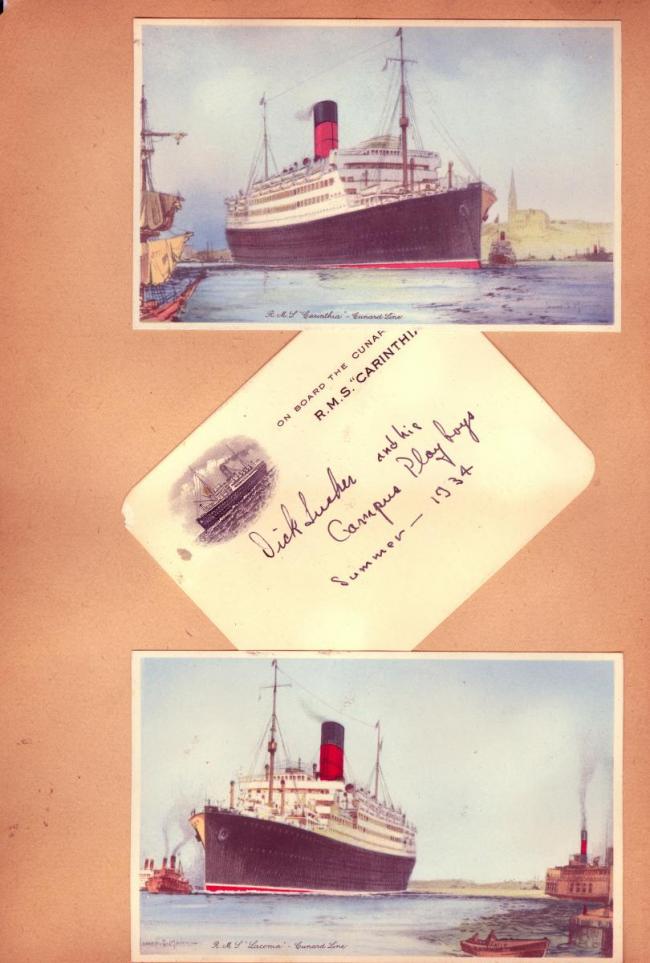
The Laconia had a troubled history in the years after the band's 1934 trip. Just a few weeks later, the ship would suffer serious damage after ramming another ship in fog on the Boston to New York trip. In 1942, after being refitted for war service, she was sunk by a German submarine with the loss of over one thousand lives.
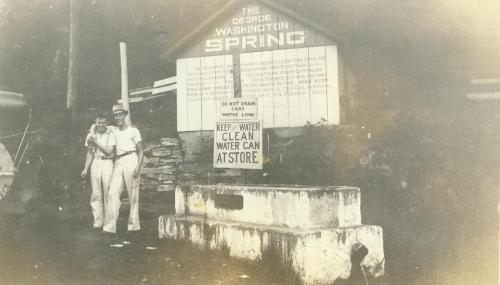
Richard Sucher and his friends disembarked on July 29 at 3PM. They did a little sightseeing and then got onto the road. They encountered car trouble in New York State, visited Niagara Falls, and then had car trouble again in Detroit. After some good mechanical assistance, they pulled into the Century of Progress World's Fair in Chicago at noon on August 3. The walked the entire fairgrounds, ran into some Teachers College classmates, and then left for Iowa at 10PM. They reached Marion at 8:30AM on August 4. After visiting there, they went up to Cedar Falls for more visiting. Then they all scattered to their respective homes, with Richard Sucher heading for his parents' farm in Story City. They had been gone for just over two months.
In an interesting sidelight, three of the band members made another trip to Europe in 1935. Richard Sucher did not accompany them, so that brief story is told elsewhere.
Life After the Trip
After returning to Iowa, Richard Sucher spent some time with his family. There were likely many summer farm chores for him to do. Then he took a position in Yorktown, near Clarinda, Iowa, where he taught manual arts and music in the 1934-1935 school year. In the summer of 1935 he returned to the farm. While helping his father in the hay mow, he fell and seriously injured his back. This would cause problems for him later in life. He then taught at the Wales-Lincoln School near Red Oak, Iowa, in the 1935-1936 and 1936-1937 school years. He studied music at Northwestern University in the summer of 1936. He taught at Redfield in the 1937-1938 school year.
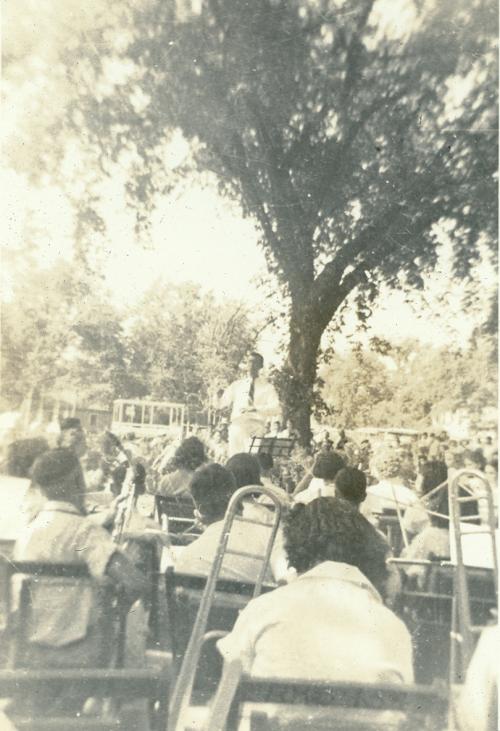
He had corresponded with several young women during his trip to England, but nothing seems to have come of that. Then, thanks to the persistence of mutual acquaintances, he met Mary Florence Coughlan, a schoolteacher and talented musician from Des Moines. They met at a music contest in Mt. Ayr, Iowa. In a noteworthy coincidence, Richard Cobb Sucher, II's, wife Billie is also from Mt. Ayr. Richard Sucher and Florence Coughlan married on February 15, 1939. Richard's brother Robert was the best man at the wedding.
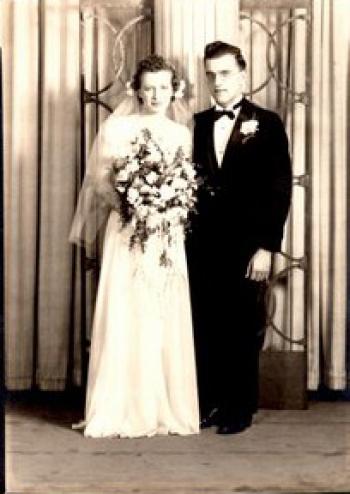
Mary Florence Coughlan, known as Florence, was born on January 20, 1912, in Des Moines, Iowa. Her father was James Joseph Coughlan, who was born in Rock Island, Illinois, on May 20, 1877. Her mother was Syster Marie (Mary) Johnson, born on January 9, 1880, in Svenarumm, Jonkoping County, Sweden. The Johnson family emigrated from Sweden to Villisca, Iowa, in July 1880. James Joseph Coughlan married Mary S. Johnson on June 19, 1907.
The terrible Iowa winter weather of the 1930s had convinced both Richard and Florence Sucher that they wanted to live in a more congenial climate. So they moved to Amarillo, Texas, where Richard took a job teaching instrumental music and selling band instruments in a private music school and store. They moved to Sherman, Texas, in the fall of 1940. The attack on Pearl Harbor made them realize that life was going to change significantly for the next few years. They decided that they needed to be closer to home. So they moved back to Des Moines in January 1942. Richard was classified 4-F in his draft physical examination, likely due to his farming accident in 1935. Thus, he was almost certainly exempt from military service. He enrolled in the pre-med course at the University of Iowa and picked up work wherever he could find it, including building maintenance, taxi driving, and Navy School canteen service. He finished the pre-med course on August 1, 1943, and was accepted at the University of Texas medical school. That course would start on September 1, 1944. Unfortunately, prior to his enrollment date, changes in war emergency regulations limited the enrollment of men with 4-F draft status into medical schools. So, Richard Sucher was not allowed to enroll.
With the birth of Richard and Florence Sucher's first child, Meredith, and with medical school no longer a possibility, Richard needed a job. A friend in Mason City, Iowa, offered him a position in his music store. Richard would work in the store and also pick up extra money directing bands in near-by small town schools. So that is what he did from September 1943 through August 1945. With the end of the war, the family moved to Waterloo, Iowa, where he opened his own store, Richard's Music Mart at 615 Commercial. He sold records, instruments, pianos, and sheet music. He also repaired instruments. He worked hard at his new business and became active in the Waterloo Jaycees.
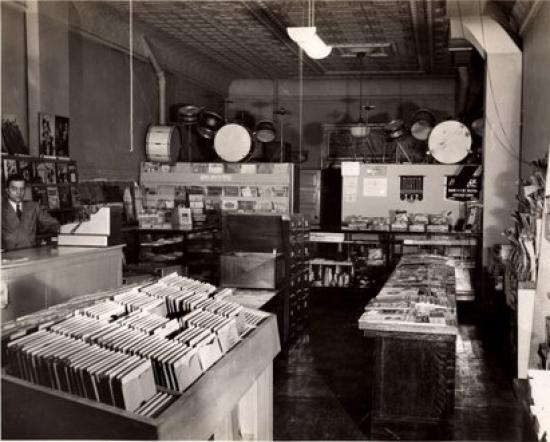
The family initially lived at 806 Clay Street in Cedar Falls, a house that Richard's father Harvey had built for his parents in 1922. Richard's family later moved to Waterloo, in order to be closer to the business. They lived first at 307 Denver Street and then at 1519 West Fourth Street. The West Fourth Street address is now the site of the Locke Funeral Home. Their other three children--Richard Cobb Sucher, II (1946), Mary Sheldon Sucher (1947), and Steven Harvey Sucher (1953)--were born while the family was in the Cedar Falls/Waterloo area. Richard Sucher also picked up a little extra money by playing in a small house combo at the Tippy Tin Inn, a popular restaurant in Cedar Falls.
By 1952, the Music Mart business was not going especially well. So, in 1953, Richard closed the business. He took the store's remaining inventory, and the family moved to Pasadena, Texas, where Richard worked as a branch manager for the Parker Music Company. In September 1959 Richard started a business in which he supervised private school band programs. He led that work in as many as twenty schools. He also worked for about a year in New Orleans for a company called Educational Gateways, which was in the private school music business. This job required him to be away from his family, who stayed in Texas. He received an offer from the Pfanstiehl Company to act as their sales representative. At that time, the Pfanstiehl Company specialized in phonograph styluses and other specialized electronic equipment. Richard initially took the Pfanstiehl job on a part-time basis, but ultimately he moved to full time with the company. The work required him to be on the road a great deal of the time and often for long periods. His territory included Texas, Arkansas, Oklahoma, New Mexico, and Louisiana. With the family now living in Houston, Richard pursued a long and successful career with the Pfanstiehl Company.
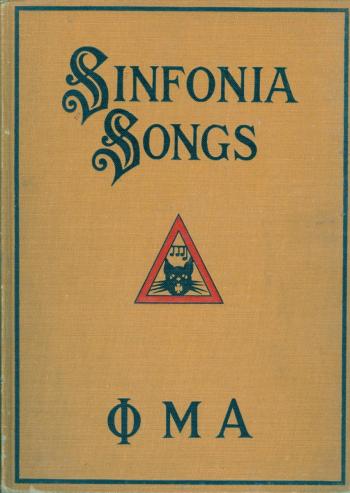
As at least partial retirement approached, Richard cut back his sales territory in 1975. He and Florence moved to Beaver Lake, east of Rogers, Arkansas, in 1979. Richard continued to work part-time even after he and Florence moved to Arkansas. Sometimes Florence accompanied him on his sales trips. And he usually spent a few days each month in Houston. The Sucher family had always enjoyed traveling and camping. Richard and Florence did even more of that after they moved to Arkansas. They visited family and friends all around the country, but they usually spent winters in warm climates. In 1983 they visited the University of Northern Iowa campus to attend Richard's fiftieth anniversary reunion of the Class of 1933. There he had the pleasure of singing with old Minnesinger friends at an event hosted by the Varsity Men's Glee Club.
In 1985, Richard was diagnosed with Chronic Lymphatic Leukemia. Medication enabled him to live a reasonably good life for a few more years. But his health showed clear signs of decline in 1989. In August he contracted a serious infection. On October 30, 1989, in Houston, Texas, Richard Sucher died.

Some years after Richard Sucher's death, his widow, Florence Sucher, married Emil Henry Jebe. Emil Jebe was born on February 26, 1909. Mr. Jebe and his first wife, Noma Rupprich Jebe, were benefactors of the Gallagher-Bluedorn Performing Arts Center on the campus of the University of Northern Iowa. Mr. Jebe died on May 18, 1996. Florence Sucher Jebe died on November 19, 2005, in Alexandria, Virginia. Both Richard and Florence Sucher were cremated. There is a marker for them in the Martin Cemetery, Larue, Arkansas.
Summary
Richard Sucher grew up in a family in which hard work was a necessity. He probably gained his determination and leadership skills from his determined mother. And he gained his creative and artistic bent from his father. In a time when few young men graduated from high school, both he and his brother graduated with four year college degrees. Those degrees gave them credentials for professional careers. Both Richard and Robert likely supported themselves entirely during their college years.
Robert Sucher graduated with a Bachelor of Arts in Education a term ahead of his brother Richard. Because Robert could not find good teaching positions, he went to Story City to help his father on the farm. In 1936, he became a dairy herd cow tester in Linn and Cedar Counties. In 1937 he moved back closer to his parents when he was appointed Assistant County Extension Director for Boone County. In 1938, he married Virginia Mae Schroeder. In late 1939 or early 1940, Robert Sucher became Assistant County Extension Director for Polk County. After 1941 he managed feed mills in Spencer and Cherokee. In 1945 he bought a feed mill and elevator business in Stanwood. He was also involved in the grocery business and in apartment management. In 1962, he started an income tax business in Ames. He sold that business in 1985. He died in 1999.
Leading the Campus Playboys was probably the primary means by which Richard Sucher earned money during and for a short while after college. His classroom performance likely suffered as a consequence of leading the band, but he had little choice. With the difficult situation of the early 1930s and with his own family's troubled financial state, he might have believed that a trip to Europe would be a brief but pleasant reward for his hard work in achieving a degree. It was likely also a way in which he could actually see and experience some of the things that he had studied in college. It would flesh out what he had learned in classrooms and read in textbooks. And maybe he saw it as a final taste of freedom before he buckled down to the responsibilities of a job and family. Since he certainly could not afford to travel in style, he had to find a way to make the trip with minimal expense. He would, of course, need the cooperation of his bandmates, but Richard Sucher was the one who made the whole trip happen.
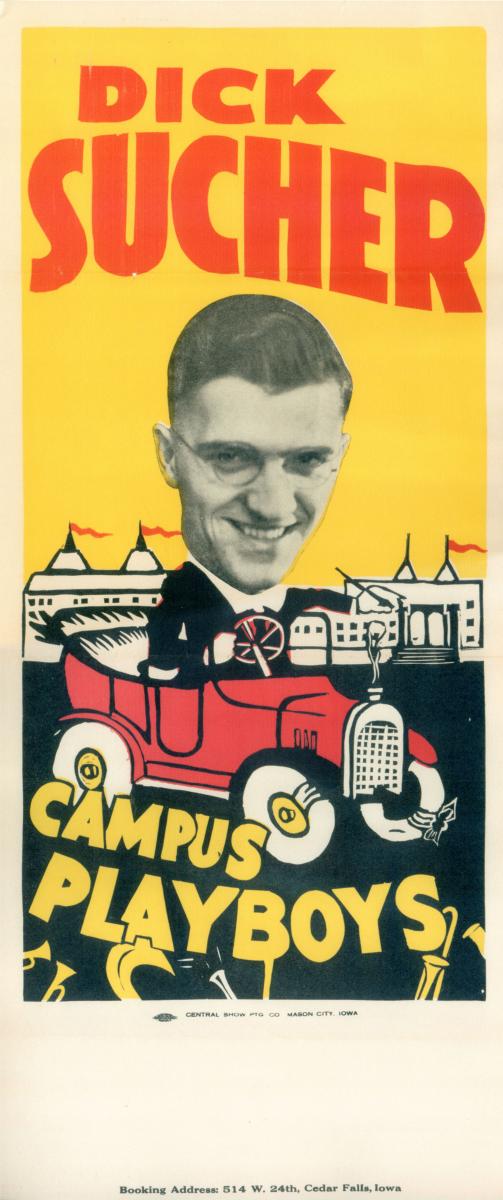
From his first days aboard the Carinthia, Richard Sucher's outlook expanded. He spoke with people whose lifestyles and talents were far beyond anything he had ever experienced in Iowa. While his bandmates remained his good friends, he occasionally expressed something approaching mild embarrassment at their behavior. By no means did he express his own superiority. Rather, he was simply dazed by the new people whom he had met, and his bandmates suffered at least slightly in comparison. He spent as much time as possible with his new shipboard friends, because he was dazzled by their casual display of knowledge, talent, and experience.
When he landed in England, he continued his companionship with several of his shipboard friends for a few days. He got his bearings in the London metropolis, hung out in mildly Bohemian parts of the city, and firmed up plans for his itinerary. But once his new friends moved on from London, Richard Sucher was completely on his own. He knew where he wanted to go. He knew how much money he had in his pocket. He needed to see if those two things would come together.
Richard Sucher must have been in extraordinary physical condition. Long daily rides, sometimes in excess of eighty miles in less than ideal weather, on a cheap, used bicycle are a testament to his remarkable stamina. And there was seldom a hot meal, a warm bath, or a comfortable bed at the end of the day. Most often he bought food from farmers or shops along the way. Frequently his bed was a haystack. Yet the number of historical and literary sites that he visited is scarcely imaginable. He visited just about all of the major sites from London, up to the Scottish border, and over to Liverpool.
Despite that hectic travel schedule, Richard Sucher also took time to visit with English people and learn about their country. He compared notes with farmers on American and English agriculture. He talked with students at Oxford and Cambridge Universities. He made friends with young people in London. He learned English terms, such as "bonnet" for an automobile hood. He tried to play cricket. He enjoyed new drinks in occasional pub stops and new foods when he visited English homes. He learned how to ride on the left side of the road. He seemed receptive to just about every new thing that he encountered. He records almost no unpleasant experiences with the English. Perhaps his inquiring, open, and courteous manner had something to do with that.
He managed all of these experiences against a constant and worrisome background of limited financial resources. He had a small amount of money on hand, but it was insufficient to cover anything out of the ordinary or much beyond the level of necessity. He likely did not join his bandmates on the Continent because he did not have enough money. If he had a tear in his clothing, he sewed it up. If he had a flat bicycle tire, he fixed it again and again, if necessary. Replacing a worn out bicycle tire or making more extensive repairs were serious financial matters. When he got to London, his shipboard friends stayed at a nice hotel. He stayed in a room with limited facilities. When he and his bandmates got together again in England, they stayed in a hostel. He stayed in a haystack. When they headed north, where things might be more expensive, he headed into a part of the country where things might be cheaper. Getting to Liverpool, on time and with at least a little money in his pocket, was critical. It was fortunate that he faced no true emergencies on his trip.
Richard Sucher was a keen observer, who wished to remember what he had seen. He collected and preserved all sorts of little souvenirs, such as luggage tags and menus. He took photographs of things that impressed him, even though film and development added to his expenses. And it took discipline to sit down at the end of a long ride and record his observations, impressions, and opinions. Yet he did that almost every day. His journal notes are a nice combination of facts, such as his daily mileage readings, and more personal thoughts. His journal was his closest companion. There he could confess his loneliness, anticipate his return to the United States, wonder if he would receive any letters, or even speculate on women's clothing styles.
When Richard Sucher returned from his trip, he was obviously richer for the experience. Yet he quickly faced his responsibilities. Within a bit more than a month of his return, he had a teaching job. And he continued to help his parents when he could. Just a few years later he married and moved on to music sales and instruction. An unfortunate circumstance derailed his potential medical career during World War II, so he returned to music to support his wife and children. After a few years as a music shop owner, he became a sales representative for a large music equipment company, where he worked with considerable success for most of the rest of his life.
Richard Sucher's trip to England in 1934 was a remarkable achievement. Judging by the amount of material that he saved from that trip, he must have had fond and lasting memories of the whole experience. Much of that material is now available for research in the University of Northern Iowa Archives.

Personal Tribute
Regardless of the obstacles, challenges, or struggles that Richard Sucher confronted in his life, he always persevered and pressed on. His legacy is the quiet love he felt for his family and the extraordinary measures he took to provide for them. His legacy is that he installed a strong work ethic required to overcome hardships and to persevere to achieve life's goals. Richard Sucher never quit--he never gave up. His genial, affable demeanor was a beacon for lasting friendships, both personal and professional. From his roots in Iowa, to raising his family in Texas, and his eventual retirement to Arkansas, he built a path for each of us to follow. Because of him, we treasure Midwestern values, coupled with a Texas Lone Star spirit and an appreciation for Arkansas's natural beauty. To this day, Richard Sucher lives on through each of us. "Forty for now."
Meredith Sucher Wade, Richard Sucher II, Sheldon Sucher Thompson, and Steven Sucher.
The children of Richard Cobb Sucher
Essay by University Archivist Gerald L. Peterson and scanning by Library Assistant Joy Lynn and additional scanning by Library Assistant Bill Maravetz; information, images, and personal tribute provided by the Sucher family; photo of Teachers College banner by Access Services Coordinator Linda McLaury; November 2014-February 2015; last updated, March 10, 2015 (GP).
